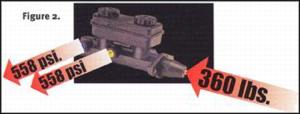- The Master Cylinder
- The
next step in the brake system is to convert the amplified force
from the brake pedal into hydraulic fluid pressure. The master
cylinder, consisting of a piston in a sealed bore with the brake
pedal output rod on the one side and brake fluid on the other,
performs this task.
-
- As
the pedal assembly output rod pushes on the piston, the piston
moves within the cylinder and pushes against the fluid, creating
hydraulic pressure. It's really that simple; however, in order
to determine how much pressure is generated at the master cylinder,
we will need to dig into a few fluid calculations. Don't surf
to the classified ads just yet.
-

The pressure generated
at the master cylinder is equal to the amount of force from the
brake pedal output rod divided by the area of the master cylinder
piston. If we assume a master cylinder diameter of 0.90 inches
(with an area of about 0.64 square inches), the calculated pressure
will be 558 pounds per square inch from the 360 pounds of pedal
output force from above {360 lbs / (0.64 in. x 0.64 in.)}. Whew, no more math
for a minute--just stare at Figure 2 (above) for a while.
-
- So,
does this pressurized hydraulic fluid stop the car? Again, the
answer is no, but like the brake pedal, making changes to the
master cylinder can impact other characteristics of the brake
system.
Increasing the master
cylinder piston diameter will decrease the amount of pressure
generated in the fluid for a given input force. In the example
above, if a 1.0 inch master cylinder were to be substituted, the
output pressure would fall to approximately 450 psi -- a pressure
reduction of nearly 20 percent for a O.1-inch increase in diameter.
Small changes here make a big difference.
Decreasing the master
cylinder piston diameter works the same principle in reverse.
Swapping in a 0.80-inch master cylinder will increase pressure
to over 700 psi--this a 25 percent increase for a O.1-inch decrease
in diameter.
-
- Given
the relationship between master cylinder piston diameter and
hydraulic force, it may seem desirable to use the smallest master
cylinder possible. However, since there will always be some
compliance (see the
sidebar) within the system, the braking
system has to have enough additional hydraulic fluid on hand
to fill all the extra volume caused by the flexing of components
during the compliance phase.
|
- Unfortunately,
this is accomplished by increasing the diameter of the master
cylinder-which, we just learned, reduces the pressure generated.
Therefore, one has to make sure that the master cylinder has
a large enough diameter to meet the fluid volume requirements
of the system, but is small enough to generate the pressure required.
(There's never an easy answer, is there?)
-
- The Brake Tubes and Hoses
- On
the surface, the brake tubes and hoses have one of the easiest
jobs in the braking system: transporting the pressurized brake
fluid away from the master cylinder to the four corners of the
car. It would be ideal to use the most rigid material possible
to minimize the compliance in the system. However, since the
braking components at the wheels (calipers, pads, and rotors)
are usually free to move around with the wheels and tires, a
flexible portion is required--and flex equals compliance.
Traditionally, auto manufacturers
have used rigid steel tubing to get the fluid almost all the
way there, and a short length of rubbercoated nylon tubing to
make the connection to the moving stuff, but even this short
section of flexible tubing can cause significant compliance
in a racing application.
-
- For
this reason, we racers prefer to replace the rubber hose with
a nylon tube covered by stainless steel braiding. Most people
notice the reduction in brake pedal travel due to the reduced
compliance immediately, but it usually depends on how old and
compliant the old rubber-coated hoses were at the time of replacement.
Although those cool-looking
stainless steel brake lines alone will not make your car stop
any faster, the decrease in compliance and improvement in pedal
feel can make a driver much more confident. They will probably
provide some increased level of resistance to damage from flying
debris as well. Did we mention they look cool?
The Caliper
- The
caliper is one of the most familiar components to the racer,
yet sometimes the most misunderstood. Like the master cylinder,
the caliper is just a piston within a bore with pressurized fluid
on one side. While the master cylinder used mechanical force
on the input side to create hydraulic force on the output side,
the caliper does the opposite by using hydraulic force on the
input side to create mechanical force on the output
side. The top view shown in Figure 3 (next page) illustrates
how the pressurized brake fluid working against the back side
of the piston is converted into a squeezing or clamping force.
 
|